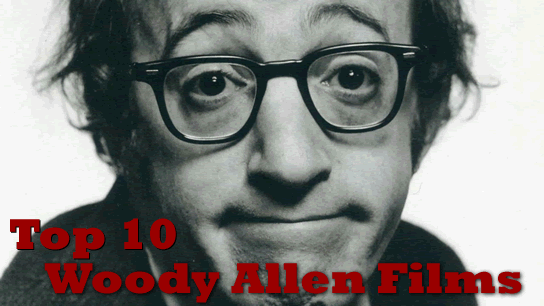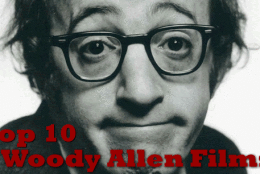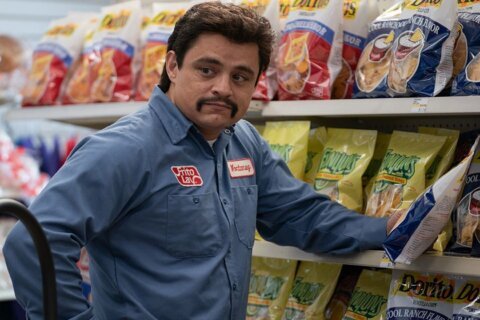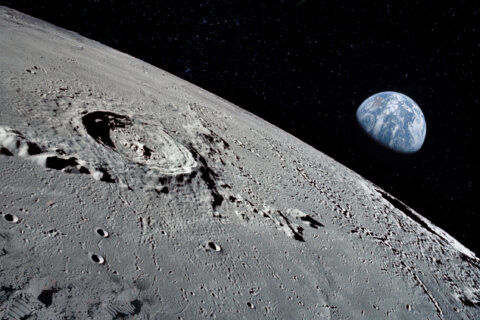
After the success of "Goodfellas" (1990) and "A Bronx Tale" (1993), Woody Allen gave his own spin on the gangster picture with this romp in 1920s New York.
Struggling playwright John Cusack is forced to cast a mobster's talentless girlfriend in his latest play in order to get it produced.
Cusack is solid, but this one's all about the supporting cast, earning Oscar nominations for Chazz Palminteri and Jennifer Tilly, while winning Best Supporting Actress for Dianne Weist, who offered up arguably the most quotable line in Allen's canon: "Don't Speak."
Few premises are cooler than a neurotic film critic getting dating tips from his imaginary friend, Humphrey Bogart.
Woody Allen and Diane Keaton recreate the finale of "Casablanca," whose famous line "Play it, Sam" was forever confused by Allen's title, which itself played off The Marx Brothers' misconception.
When Chuck Workman created his famous "100 Years at the Movies" montage for Turner Classic Movies, this was the sole Woody Allen film featured, showing a clip from the hilarious record-smashing scene.
When it comes to his best of the 21st century, it's a battle between "Match Point" (2005) and "Midnight in Paris." I have to go with the latter, which won Allen his third Oscar for Best Original Screenplay.
The time travel fantasy was as much a love letter to Paris as it was a warning against nostalgia. It was also Allen's most financially successful, possibly due to the casting of Owen Wilson and Rachel McAdams.
During Oscar season, I gave it 3.5 out of 4 stars, fearful of giving the top score to three flicks in a month ("The Artist" and "The Descendants"). In hindsight, I wish I could go back in time to say this is a 4 star romantic comedy and one of Allen's best.
Twenty-six years before "Austin Powers," Woody Allen told the tale of a nerd who is cryogenically frozen only to wake up in the future.
"Sleeper" came during Allen's earlier, sillier phase (i.e. "Bananas"), before growing into the more refined work of Oscar-winning "comedies of manners."
More importantly, it was his first script collaboration with Marshall Brickman, head writer of "The Tonight Show with Johnny Carson," who later helped him write "Annie Hall" (1977), "Manhattan" (1979) and "Manhattan Murder Mystery" (1999).
Alright, I'll admit, I'm a little biased when it comes to radiowaves. But Woody Allen's "Radio Days" is a deliciously nostalgic look at the medium's Golden Age.
The film features vignettes of various radio personalities, all layered with a killer soundtrack from Glenn Miller to Tommy Dorsey to Duke Ellington.
Allen inserts many of his own memories in this story of a working class family in Rockaway Beach, New York, from the late '30s to New Years Eve 1944. Future "Austin Powers" star, Seth Green, plays Allen's boyhood self.
Arguably the best love note to a city ever done, Woody Allen showers Manhattan with fireworks, George Gerswhin and the gorgeous black-and-white cinematography of Gordon Willis.
In a preview of his future personal life, Allen plays a divorced writer who tries getting over his ex-wife (Meryl Streep) by dating both his best friend's mistress (Diane Keaton) and an innocent high-schooler (Oscar nominee Mariel Hemingway).
As director, Allen uses background anatomical skeletons to portray the "mind/body" disconnect of being "too cerebral." As writer, his final speech on "why life is worth living" remains one of my favorite moments in movie history.
Few writers can write one Oscar-winning screenplay, let alone three. "Hannah and Her Sisters" intertwined the love lives of so many characters so brilliantly that the Academy couldn't ignore him, and it remains one of five of his scripts on the WGA's Top 101 Screenplays.
The film follows the time span between two Thanksgivings, where Hannah's (Mia Farrow) husband (Michael Caine) falls in love with her sister (Barbara Hershey), while her hypochondriac ex-husband (Woody Allen) rekindles his relationship with her sister (Dianne Wiest). Caine and Weist both won Oscars.
Woody Allen called it his personal favorite of all of his films. "Purple Rose" has the genius premise of a Depression Era housewife (Mia Farrow), who goes to her small-town movie theater to escape her abusive relationship. Suddenly, one of the film's characters, Tom Baxter (Jeff Daniels), comes off of the screen to meet her, and the two develop a fantasy romance.
Allen said he loved the premise, but didn't quite have a complete movie until he came up with the next twist.
The real-life actor who plays Baxter (also Daniels) flies from Hollywood to Farrow's small town to convince Baxter to return to the screen. When he, too, falls for Farrow, it's a delicious love triangle and an ode to the power of movies.
A No. 2 position doesn't seem to do this one justice, as "Crimes and Misdemeanors" is one of the most brilliant movies of the 20th century.
Martin Landau plays an opthamologist whose mistress (Anjelica Huston) threatens to reveal their affair to his wife. He opts to kill her, sweeping the affair under the rug and leading to a powerful black-tie exchange between Landau and Allen on how humans rationalize things to justify immoral behavior.
Which bad deeds are crimes and which are misdemeanors? The film's final philosophical voiceover closes the tragedy beautifully.
Romantic comedies don't just go around sweeping the Oscars. But Woody Allen's "Annie Hall" did just that, winning four, including Best Picture, Best Director, Best Original Screenplay and Best Actress (Diane Keaton).
Voted the No. 6 Greatest Screenplay of All Time by the WGA, Allen shattered storytelling conventions with split-screen, conflicting subtitles, characters pulling new characters in from off-frame, a flashback to Allen's childhood, even an animated sequence.
Most memorably, Keaton got us all saying "La Di Da," inspired a fashion craze of the '70s, and reminded us all how badly "we need the eggs."

Jason Fraley, WTOP film critic
WASHINGTON – Say what you will about Woody Allen’s personal life (his son, Ronan Farrow, recently took a Father’s Day jab), but as a filmmaker, he is unbelievably prolific.
At age 76, the Woodman has written and directed 42 films – some duds, some masterpieces – but each with the same auteur staples, from black-and-white opening credits, to forbidden love swaps eloquently penned in a comedy of manners. Who but Allen could win Best Original Screenplay in three different decades? In 2011 there was no better screenwriter, just like 1986 and 1977.
The 21st century has quickly become Allen’s “postcard period,” the fanny-pack musings of a workaholic filmmaker in the twilight of his life. “To Rome with Love” continues his Euro Tour after stops in London for “You Will Meet a Tall Dark Stranger” (2010), Barcelona for “Vicky Cristina Barcelona” (2008), and Paris for “Midnight in Paris” (2011), a tough act to follow.
If “Midnight in Paris” was a warning against nostalgia, “To Rome with Love” is a commentary on fame, using four interwoven plots to expose the artificial line between the “ordinary” and the “celebrity.”
1) Woody Allen and Judy Davis fly to Rome to meet their daughter’s fiance, whose father wows Allen by singing opera in the shower. As a former opera director, Allen gets him an audition, but the father clams up in the spotlight. This sparks Allen’s “genius” idea of bringing a portable shower on stage, lathering in the symbolism that this man is only capable of fame in his most private, naked state.
2) Jesse Eisenberg is an architect seduced by his girlfriend’s sex-crazed best friend (Ellen Page), who flies in from Hollywood. Alec Baldwin sees Eisenberg as a younger version of himself and wants to warn him against Page’s phony cultural pretenses. So, like the imaginary friend Bogart in “Play it Again, Sam” (1972), Baldwin pops up during intimate moments to provide advice.
3) Alessandro Tiberian and Alessandra Mastronardi are a newlywed couple who botch plans to “meet the parents” with a case of mistaken identity. The tame husband is accidentally sent a Spanish hooker, played by Penelope Cruz, while the virginal wife is seduced by her favorite Italian movie star. “I’ve always wondered what it would be like to kiss a movie star,” she says, as the actor reveals himself to be an average, everyday horn-dog.
4) Finally, Roberto Benigni is a regular joe who’s plucked from obscurity to become an overnight celebrity. Suddenly, paparazzi are following him everywhere, asking him mundane questions like how he butters his toast. It’s a classic case of celebrities who are “famous for being famous.” At first, Benigni demands his privacy, but when his 15 minutes are over, he’s left craving the spotlight.
Such thematic musings are what make Allen’s career great, providing a layer of substance beneath the sexy affairs and paranoid punchlines. The fact that this commentary unfolds with such reckless comedic abandon is a bonus, capturing the charming silliness of Bunuel’s “Discreet Charm of the Bourgeoisie” where we feel like anything can happen at any moment.
Whether or not you like the movie will depend on whether you’re already a fan of Allen’s work. Indeed there are folks who prefer him staying behind the camera, as was the case in gems like “The Purple Rose of Cairo,” “Match Point” and “Midnight in Paris.” “Rome” is more apt to please the diehards, as Allen once again casts himself as a neurotic whiner. Either you’re a fan of that schtick, or you’re not. Luckily I am, if only because I appreciate how effectively he has turned it into an archetype. Allen’s own self-caricature has become as iconic as John Wayne’s cowboy or Chaplin’s Tramp.
Here, the writing is clearly not his best effort. Many of the jokes don’t land, the “narrator” bookends don’t fit, and Baldwin’s dialogue appears half-hearted for the first third of the movie. The casting of so many non-Italians is also questionable, but just like Gene Kelly was “An American in Paris,” Allen has organized a collection of “Americans in Rome,” because that’s the perspective he knows.
I’ve enjoyed his romp across Europe, perhaps because I share his outside-looking- in approach. His foreign travels are presented through the prism of pop culture references, so when Allen visits Roman landmarks — the Coliseum, the Trevi Fountain — I can’t help but think of Rossellini’s “Rome Open City,” Wyler’s “Roman Holiday” or Fellini’s “La Dolce Vita.”
Allen’s wide-eyed adoration of the Eternal City drips from every frame, thanks to gorgeous cinematography from “Midnight in Paris” collaborator Darius Khondji and a catchy soundtrack with “Amada Mia, Amore Mio.” Sure it’s a shameless attempt to recreate the magic of Gershwin and the skyline of Manhattan, but he’s tackled New York City so much we can’t blame him for branching out.
At this point, he seems to be cranking out movies like a Hall of Fame ballplayer padding his stats. What truth in a scene where Allen says he’s getting old, and Davis says he was a man ahead of his time. The eternally paranoid Allen wants to leave as many films behind as possible so that they’ll live on after he’s gone. It’s his unique, artistic way of conquering his fear of death, and his career is a body of work to be cherished. So if you want to apply the “Crimes and Misdemeanors” scale of greatness, “To Rome with Love” is at least a charming misdemeanor.
★ ★ ★
The above rating is based on a 4-star scale. Read more from WTOP Film Critic Jason Fraley by clicking ” Fraley on Film” under the “Living” tab above, following @JasonFraleyWTOP on Twitter, and checking out his blog, The Film Spectrum.
(Copyright 2012 by WTOP. All Rights Reserved.)








